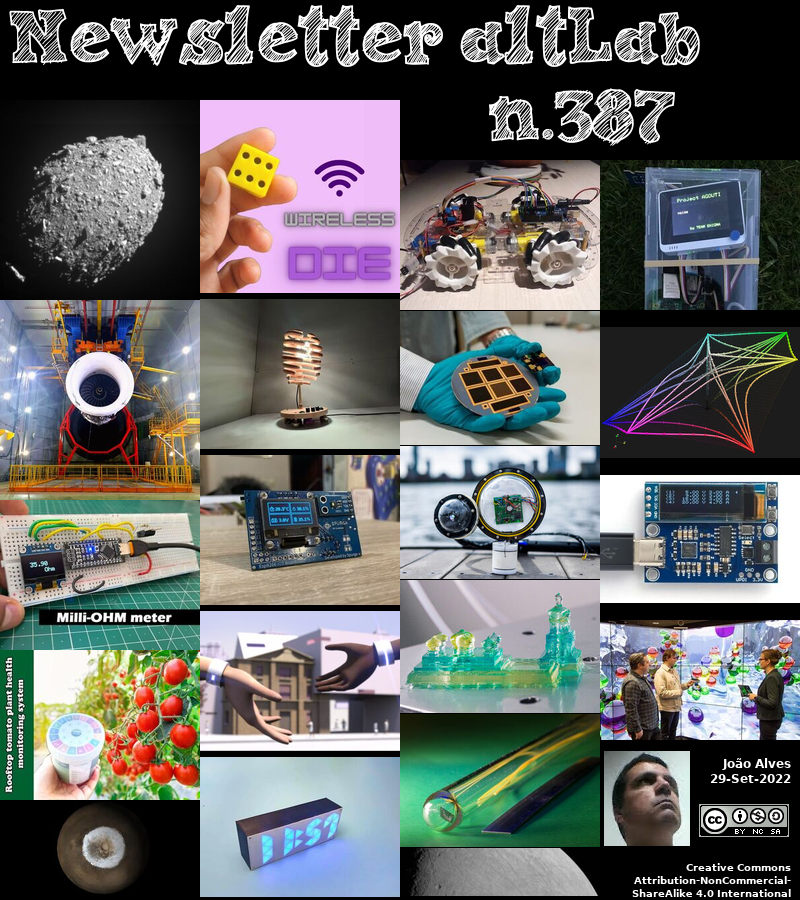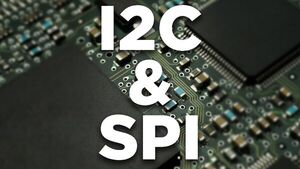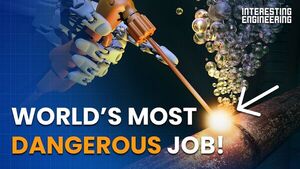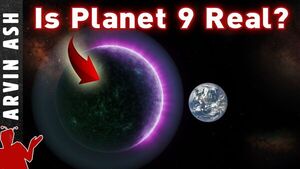2022-09-29 - Nº 387
Editorial
Esta é a Newsletter Nº 387 que se apresenta com o mesmo formato que as anteriores. Se gostar da Newsletter partilhe-a!
Todas as Newsletters encontram-se indexadas no link.
Esta Newsletter tem os seguintes tópicos:
Faz hoje anos que nascia, em 1803, o matemático francês Jacques Charles-François Sturm. Ele é responsável pelo teorema de Sturm, uma importante contribuição para a teoria das equações. Enquanto tutor da família de Broglie em Paris (1823-24), Sturm conheceu muitos dos principais cientistas e matemáticos franceses. Em 1826, com o engenheiro suíço Daniel Colladon, ele fez a primeira determinação precisa da velocidade do som na água. Um ano mais tarde escreveu um ensaio premiado sobre fluidos compressíveis. Desde a época de René Descartes, existia o problema de encontrar o número de soluções de uma dada equação diferencial de segunda ordem dentro de um determinado intervalo da variável. Sturm forneceu uma solução completa para o problema com o seu teorema que apareceu pela primeira vez em Mémoire sur la résolution des équations numériques (1829; "Tratado sobre Equações Numéricas"). Estes princípios foram aplicados no desenvolvimento da mecânica quântica, como na solução da equação de Schrödinger e dos seus valores-limite.
Faz também hoje anos que nascia, em 1899, o inventor húngaro-argentino László Bíró. Ele patenteou a primeira esferográfica moderna comercialmente bem sucedida. A primeira esferográfica tinha sido inventada aproximadamente 50 anos antes por John J. Loud, mas não foi um sucesso comercial.
Faz igualmente hoje anos que nascia, em 1901, o físico ítalo-americano Enrico Fermi. Ele recebeu o Prémio Nobel da Física em 1938 como um dos principais arquitectos da era nuclear. Foi o último dos físicos de dupla ameaça: um génio na criação tanto de teorias esotéricas como de experiências elegantes. Em 1933, desenvolveu a teoria do decaimento beta, postulando que o recém-descoberto decaimento de neutrões a um protão emite um electrão e uma partícula a que chamou um neutrino. O desenvolvimento da teoria para explicar este decaimento resultou mais tarde na descoberta da fraca força de interacção. Ele desenvolveu as estatísticas matemáticas necessárias para esclarecer uma grande classe de fenómenos subatómicos, descobriu a radioactividade induzida por neutrões, e dirigiu a primeira reacção em cadeia controlada envolvendo a fissão nuclear.
Faz também hoje anos que nascia, em 1920, o químico britânico Peter D. Mitchell. Ele recebeu o Prémio Nobel da Química de 1978 por ajudar a esclarecer como o ADP (adenosina difosfato) é convertido no composto energético ATP (adenosina trifosfato) nas mitocôndrias das células vivas.
Faz igualmente hoje anos que nascia, em 1925, o engenheiro e inventor norte-americano Paul MacCready. Ele inventou não só as primeiras máquinas voadoras movidas a energia humana, mas também as primeiras aeronaves movidas a energia solar a fazer voos sustentados. A 23 de Agosto de 1977, o avião movido a pedal, o Gossamer Condor, voou com sucesso uma rota de 1,15 milhas em número de 8 para demonstrar um voo sustentado e manobrável, pelo qual ganhou o Prémio Kremer de 50.000 libras (95.000 dólares). MacCready desenhou o Condor com o Dr. Peter Lissamen. A sua estrutura era feita de tubos finos de alumínio, cobertos com plástico mylar apoiado com fio de aço inoxidável. Em 1979, o Gossamer Albatross ganhou o segundo Prémio Kremer por ter feito um voo através do Canal da Mancha.
Por fim, faz hoje anos que nascia, em 1931, o físico de partículas norte-americano James Watson Cronin. Ele partilhou (com Val Logsdon Fitch) o Prémio Nobel da Física de 1980 pela "descoberta de violações dos princípios de simetria fundamental na decadência dos K-mesons neutros". A sua experiência provou que uma reacção inversa não segue o caminho da reacção original, o que implicava que o tempo tem um efeito sobre as interacções subatómicas de partículas. Assim, a experiência demonstrou uma quebra na simetria partícula-antipartícula para certas reacções de partículas subatómicas.
Faz hoje 68 que era fundada a Organização Europeia para a Investigação Nuclear, mais conhecida por CERN (derivado do nome Conseil européen pour la recherche nucléaire). Foi inicialmente constituido por 12 membros fundadores: Bélgica, Dinamarca, França, República Federal da Alemanha, Grécia, Itália, Países Baixos, Noruega, Suécia, Suíça, Reino Unido, e Jugoslávia. Actualmente tem 23 membros e das descobertas feitas por esta organização destacam-se a descoberta de correntes neutras na câmara da bolha da Gargamelle em 1973, a descoberta dos bósons W e Z nas experiências dos UA1 e UA2 em 1983, a determinação do número de famílias de neutrinos leves no Large Electron-Positron Collider (LEP) a operar no pico do bosão Z em 1989, a primeira criação de átomos anti-hidrogénio na experiência PS210 em 1995, a descoberta da violação directa da CP na experiência NA48 em 1999, o Programa Heavy Ion descobriu um novo estado da matéria, o Plasma Quark Gluon em 2000, o isolamento de 38 átomos de anti-hidrogénio em 2010, a Manutenção de anti-hidrogénio durante mais de 15 minutos em 2011, e um bóson com uma massa de cerca de 125 GeV/c2 consistente com o bóson de Higgs, há muito procurado em 2012. É também de realçar que o projecto da World Wide Web foi incubado no CERN.
Nesta semana que passou, a NASA fez colidir a sonda DART contra um asteroide. Após 10 meses de voo no espaço, o Double Asteroid Redirection Test (DART) da NASA - a primeira demonstração mundial de tecnologia de defesa planetária - teve um impacto bem sucedido no seu alvo asteróide, a primeira tentativa da agência para mover um asteróide no espaço.
Na Newsletter desta semana apresentamos diversas noticias, artigos científicos, projetos de maker e alguns vídeos interessantes. É apresentada a revista MagPI nº 122 de Outubro e o livro "Contribute To Open Source: The Right Way 3Rd Edition".
 João Alves ([email protected])
João Alves ([email protected])
O conteúdo da Newsletter encontra-se sob a licença  Creative Commons Attribution-NonCommercial-ShareAlike 4.0 International License.
Creative Commons Attribution-NonCommercial-ShareAlike 4.0 International License.
Novidades da Semana
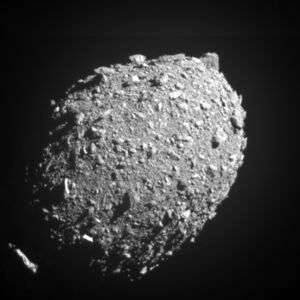
NASA’s DART Mission Hits Asteroid in First-Ever Planetary Defense Test
"After 10 months flying in space, NASA’s Double Asteroid Redirection Test (DART) – the world’s first planetary defense technology demonstration – successfully impacted its asteroid target on Monday, the agency’s first attempt to move an asteroid in space. Mission control at the Johns Hopkins Applied Physics Laboratory (APL) in Laurel, Maryland, announced the successful impact at 7:14 p.m. EDT. As a part of NASA’s overall planetary defense strategy, DART’s impact with the asteroid Dimorphos demonstrates a viable mitigation technique for protecting the planet from an Earth-bound asteroid or comet, if one were discovered. “At its core, DART represents an unprecedented success for planetary defense, but it is also a mission of unity with a real benefit for all humanity,” said NASA Administrator Bill Nelson. “As NASA studies the cosmos and our home planet, we’re also working to protect that home, and this international collaboration turned science fiction into science fact, demonstrating one way to protect Earth.” DART targeted the asteroid moonlet Dimorphos, a small body just 530 feet (160 meters) in diameter. It orbits a larger, 2,560-foot (780-meter) asteroid called Didymos." [...]
Outras Notícias

NASA’s Juno Shares First Image From Flyby of Jupiter’s Moon Europa
"Observations from the spacecraft’s pass of the moon provided the first close-up in over two decades of this ocean world, resulting in remarkable imagery and unique science. The first picture NASA’s Juno spacecraft took as it flew by Jupiter’s ice-encrusted moon Europa has arrived on Earth. Revealing surface features in a region near the moon’s equator called Annwn Regio, the image was captured during the solar-powered spacecraft’s closest approach, on Thursday, Sept. 29, at 2:36 a.m. PDT (5:36 a.m. EDT), at a distance of about 219 miles (352 kilometers). This is only the third close pass in history below 310 miles (500 kilometers) altitude and the closest look any spacecraft has provided at Europa since Jan. 3, 2000, when NASA’s Galileo came within 218 miles (351 kilometers) of the surface. Europa is the sixth-largest moon in the solar system, slightly smaller than Earth’s moon. Scientists think a salty ocean lies below a miles-thick ice shell, sparking questions about potential conditions capable of supporting life underneath Europa’s surface." [...]
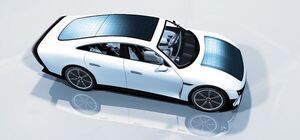
Toshiba Boosts Transparent Cu2O Tandem Solar Cell to A New High
"Researchers at Japan’s Toshiba Corporation (TOKYO: 6502) have announced a significant advance in their work to develop an efficient, low cost and highly reliable tandem solar cell that raises the output of solar panels by layering a transparent solar cell over a standard silicon cell. Building on their achievements to date, the researchers have reported a transparent cuprous oxide (Cu2O) solar cell with a conversion efficiency (PCE) of 9.5%, the highest level yet achieved for a Cu2O cell (*1). This was realized by enlarging its predecessor, announced in December 2021, and points to the potential for mass production. The new cell is expected to provide a boost for the development of EV that do not require plug-in charging, and to advance other mobility applications, such as high-altitude platform stations, telecom platforms in the stratosphere. Worldwide promotion of renewables as a mainstream energy supply, and of efforts to electrify transportation, is creating opportunities for solar cells. Toshiba is committed to using its technological capabilities to advance carbon neutrality, and as part of this is developing highly efficient and reliable low cost tandem solar cells that can be mounted on vehicles and trains, which offer only limited installation space." [...]

Intel Launches 13th Gen Intel Core Processor Family Alongside New Intel Unison Solution
"Today at Intel Innovation, Intel revealed the 13th Gen Intel® Core™ processor family, led by the 13th Gen Intel® Core™ i9-13900K – the world’s fastest desktop processor1. The new 13th Gen Intel Core family includes six new unlocked desktop processors with up to 24 cores and 32 threads and blazing clock speeds up to 5.8 GHz for the best gaming, streaming and recording experience2. Led by the launch of the Intel Core “K” processors, the 13th Gen Intel Core desktop family will consist of 22 processors and more than 125 partner system designs – providing an uncompromising experience in both application performance and platform compatibility. Enthusiasts can take advantage of 13th Gen Intel Core processors’ performance improvements with existing Intel® 600 or new Intel® 700 series chipset motherboards. Combined with both the latest DDR5 memory support and continued DDR4 memory support, users can enjoy the benefits of 13th Gen Intel Core while customizing their setup based on their own feature and budget preferences. “We are raising the standards of PC performance once again with our latest generation of flagship 13th Gen Intel Core Processors,” said Michelle Johnston Holthaus, executive vice president and general manager of the Client Computing Group at Intel." [...]
STMicroelectronics’ multi-pixel driver with CAN FD Light powers next-generation automotive lighting
"STMicroelectronics’ L99LDLH32 linear current regulator delivers a convenient, integrated solution for dynamic automotive lighting controlled using the lightweight CAN FD Light protocol. Ideal for use with OLED lamps that provide bright, homogeneous, and high-contrast lighting from a small surface area, the new driver lets designers produce complex light patterns and effects that enhance safety and styling. With 32 regulated current sources, independently programmable from 1mA to 15mA, the L99LDLH32 can drive individual pixels in external and interior lighting applications. Global dimming is also provided, with 8-bit resolution. While powered at the vehicle battery voltage, the driver produces outputs of up to 35V to cover a wide emitter forward-voltage spread. The integrated CAN FD Light protocol handler and transceiver simplify connection to the vehicle’s communication infrastructure and controlling domain ECU (electronic control unit)." [...]

AMD Launches Ryzen Embedded V3000 Series Processors Delivering New Levels of Performance and Power Efficiency for “Always-On” Storage and Networking
"AMD today introduced the Ryzen™ Embedded V3000 Series processors, adding the high-performance “Zen 3” core to the V-Series portfolio to deliver reliable, scalable processing performance for a wide range of storage and networking system applications. With greater CPU performance1, DRAM memory transfer rate2, CPU core count3 and I/O connectivity when compared to the AMD Ryzen Embedded V1000 series, the new AMD Ryzen Embedded V3000 Series processors deliver the performance and low-power options required for some of the most demanding 24x7 operating environments and workloads. Now shipping to leading embedded ODMs and OEMs, AMD Ryzen Embedded V3000 processors address the growing demands of enterprise and cloud storage, as well as data center network routing, switching and firewall security features. AMD Ryzen Embedded V3000 processors can power a variety of diverse use-cases ranging from virtual hyper-converged infrastructure to advanced systems at the edge. “We designed AMD Ryzen Embedded V3000 processors for customers seeking a balance of high-performance and power-efficiency for a wide range of applications in a compact BGA package,” said Rajneesh Gaur, corporate vice president and general manager, Embedded Solutions Group, AMD. “AMD Ryzen Embedded V3000 processors deliver a robust suite of features with advanced benefits required for superior workload performance in enterprise and cloud storage and networking products.” AMD Ryzen Embedded V3000 processors are available in four-, six- and eight-core configurations with low thermal design power (TDP) profiles spanning from 10W to 54W for storage and networking systems to enable an exacting balance of performance and power efficiency in a compact design." [...]

Renesas Launches Integrated Development Environment That Enables ECU-Level Automotive Software Development Without Hardware
"New Integrated Software Development Environment Supports Multi-Chip ECUs, Reducing Development Time and Post-Design Modifications Renesas Electronics Corporation (TSE: 6723), a premier supplier of advanced semiconductor solutions, today launched a new integrated development environment that allows engineers to rapidly create software for automotive ECUs (Electronic Control Units) containing multiple hardware devices. The fully integrated environment supports co-simulation, debug and trace, high-speed simulation and distributed processing software over multiple SoCs (System-on-Chips) and MCUs (Microcontrollers)—all without the need for actual hardware. This software development environment recognizes the automotive industry’s shift toward “Software First” product development, in which a vehicle’s value is increasingly defined by its software, as well as the “Shift Left” software design approach, which emphasizes software verification and validation earlier in the development cycle, before hardware is available. The first development environment tools are available now for the- R-Car S4 and RH850/U2A devices. “Renesas is committed to providing a development environment that helps our automotive customers realize their vision for Software First, while continuing to support their evolution toward Shift Left software development," said Hirofumi Kawaguchi, Vice President of Renesas' Automotive Software Development Division. “We are confident that this development environment will help our customers transform their E/E architecture and facilitate the early development of ECUs and new products, and ultimately deliver more value.” Integrated Development Environment for ECU Development with Multi-Device Configuration Renesas’ integrated development environment with multi-device support enables software development at the ECU level, adding additional value in vehicles and contributing to the Software First approach." [...]

STMicroelectronics expands 5V op-amp family, to optimize power and signal-conditioning performance
"STMicroelectronics has added the TSV782 high-performance dual op amp to its 5V family, with 30MHz gain bandwidth (GBW) and 50µV (typical) input offset voltage for high-speed, high-accuracy signal conditioning. Able to function with a supply as low as 2.0V, the TSV782 can operate from a deeply discharged battery and so extend the runtime of equipment such as smoke alarms. In addition, the operating current of just 3.3mA/channel helps designers maximize the application energy budget to power richer functions and capabilities such as innovative smart features and wireless connectivity. Operating down to 2.0V also lets the op amp use the same power rail as low-voltage logic devices to simplify system design and lower the bill of materials. With rail-to-rail input and output and maximum slew rate of 20V/µs, the TSV782 joins similar rail-to-rail devices in ST’s high-performance family. These include the TSV772, which has GBW of 20MHz and maximum slew rate 13V/µs, and the 50MHz TSV792 that operates at 5.5mA per channel." [...]
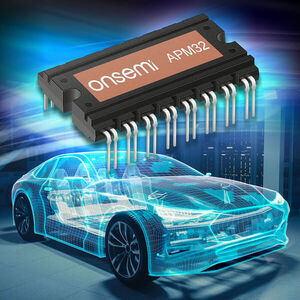
onsemi Launches Automotive Silicon Carbide-Based Power Module Trio for On-Board Chargers
"onsemi (Nasdaq: ON), a leader in intelligent power and sensing technologies, today announced a trio of silicon carbide (SiC) based power modules in transfer molded technology that are intended for use in on-board charging and high voltage (HV) DCDC conversion within all types of electric vehicles (xEV). The APM32 series is the first-of-its-kind that adopts SiC technology into a transfer molded package to enhance efficiency and shorten charge time of xEVs and is specifically designed for high-power 11-22kW on-board chargers (OBC). Each of the three modules exhibits low conduction and switching losses, combining with best-in-class thermal resistance and high voltage isolation to deal with 800V bus voltage. The enhanced efficiency and lower heat generation ultimately allow for a more powerful OBC. One that can charge the xEV faster and increase its operating range – two critical factors for consumers. “Our new modules employ the latest SiC technology to minimize losses and overall system volume, allowing designers to meet charging efficiency and space goals,” said Fabio Necco, vice president and general manager, Automotive Power Solutions at onsemi." [...]

Renesas’ ClockMatrix System Synchronizer Delivers Class D Compliance for O-RAN S-Plane Requirements
"ClockMatrix Device Provides Synchronization and Software Solution for the AMD RFSoC DFE Development Platform and O-RU Reference Design Renesas Electronics Corporation (TSE:6723), a premier supplier of advanced semiconductor solutions, today announced that its 8A34001 System Synchronizer for IEEE 1588 is being used within the AMD Zynq® UltraScale+™ RFSoC DFE ZCU670 Evaluation Kit and reference design for 5G Next-Gen Radio (5G NR). The 8A34001 System Synchronizer for IEEE 1588 is part of Renesas’ ClockMatrix™ Family of high-performance, precision timing solutions designed to simplify clock designs for high-speed applications. The 8A34001 generates ultra-low jitter; precision timing signals based on the IEEE 1588 Precision Time Protocol (PTP) and Synchronous Ethernet (SyncE). It exceeds next-generation 5G radio requirements including synchronization and offers full ITU-T G.8273.2 T-BC/T-TSC class C and D compliance. Renesas offers open-source SYNCE4L and PCM4L, that is built on open source PTP4L, and device drivers already in a Linux kernel for the 8A34001; while competing solutions rely on proprietary software that are difficult for end-customers to integrate and customize on to their SW platforms. The AMD ZCU670 is an evaluation and development platform based on Zynq UltraScale+ RFSoC DFE, the latest AMD silicon for 5G NR targeting both FR1 and FR2 (mmWave) O-RAN applications." [...]

Plan to research solar power from space
"The Sun never stops shining in space, and sunlight is much more intense there than on Earth's surface. So what if we could gather that energy up in space then beam it down to Earth? Recent studies funded by the Preparation element of ESA’s Basic Activities programme, show the concept, called Space-Based Solar Power, is theoretically workable and could support the path to decarbonising the energy sector. However, significant uncertainties and technical challenges remain. In response ESA is proposing a R&D programme to mature the concept and its critical technologies – SOLARIS. The challenge of decarbonising Europe’s energy sector over the coming few decades is a massive one." [...]

Renesas Expands RZ/V Series with Built-in Vision AI Accelerator for Accurate Image Recognition and Multi-Camera Image Support
"New RZ/V2MA MPU Features an OpenCV Accelerator for Image Processing and Offers TVM-based Deep Learning Compiler. Renesas Electronics Corporation (TSE: 6723), a premier supplier of advanced semiconductor solutions, has expanded its AI-capable RZ/V Series of microprocessors (MPUs), with a new device that enables AI processing of image data from multiple cameras, offering a new level of highly accurate image recognition for vision AI applications. Equipped with two 64-bit Arm® Cortex®-A53 cores, the new device is capable of delivering high computing performance with a maximum operating frequency of 1GHz. The RZ/V2MA features a proprietary low power DRP-AI (Dynamically Reconfigurable Processor) accelerator which can process vision AI at 1 TOPS/W (tera operations per second, per watt) class performance. The RZ/V2MA device offers high-speed interfaces such as Ethernet, USB, and PCI Express that allow image input from multiple external cameras. In addition to the DRP-AI accelerator, the RZ/V2MA includes an OpenCV accelerator that allows rule-based image processing simultaneously." [...]
Ciência e Tecnologia
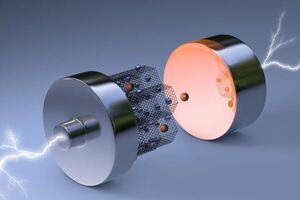
Magnetic Field Helps Thick Battery Electrodes Tackle Electric Vehicle Challenges
"As electric vehicles grow in popularity, the spotlight shines more brightly on some of their remaining major issues. Researchers at The University of Texas at Austin are tackling two of the bigger challenges facing electric vehicles: limited range and slow recharging. The researchers fabricated a new type of electrode for lithium-ion batteries that could unleash greater power and faster charging. They did this by creating thicker electrodes – the positively and negatively charged parts of the battery that deliver power to a device – using magnets to create a unique alignment that sidesteps common problems associated with sizing up these critical components. The result is an electrode that could potentially facilitate twice the range on a single charge for an electric vehicle, compared with a battery using an existing commercial electrode. “Two-dimensional materials are commonly believed as a promising candidate for high-rate energy storage applications because it only needs to be several nanometers thick for rapid charge transport,” said Guihua Yu, a professor in UT Austin’s Walker Department of Mechanical Engineering and Texas Materials Institute." [...]
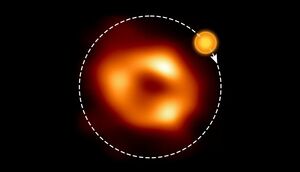
Hot gas bubble swirls around the heart of the Milky Way
"Researchers discover a hot spot near the black hole Sagittarius A* with the radio telescope ALMA There is a black hole in the centre of our Milky Way. In the immediate vicinity of this behemoth called Sagittarius A*, things are turbulent. Now an international group led by Maciek Wielgus from the Max Planck Institute for Radio Astronomy in Bonn has discovered an object that orbits the black hole on a very narrow path in only about 70 minutes. The observation of this hot spot was made with the ALMA telescope facility in the Chilean Andes. Using the Atacama Large Millimeter/submillimeter Array (ALMA), astronomers have spotted signs of a ‘hot spot’ orbiting Sagittarius A*, the black hole at the centre of our galaxy. The finding helps us better understand the enigmatic and dynamic environment of our supermassive black hole." [...]
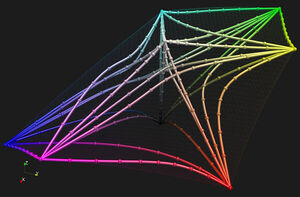
We proved Schrödinger wrong about color perception
"A project to improve data visualization ended up overturning a century-old model of color space that underpins industry standards for color everywhere from digital displays to paint. The opportunity to correct the work of Nobel Prize-winning physicist Erwin Schrödinger—yes, that Schrödinger, of quantum cat fame—comes once in a lifetime, so when my colleagues and I discovered he and others were wrong in their mathematical description of how people perceive color, we jumped on it. In my early-career research project, our scientific visualization team at Los Alamos National Laboratory wanted to develop algorithms to automatically improve the color maps underlying the images and movies that make data—numbers—easy to understand and interpret at a glance. Our minds have trouble digging meaning out of arrays of digits, but we can quickly spot patterns and trends when those numbers are converted to pictures, with colors representing different values in the data. Our visualizations help physicists, climate modelers, space weather researchers and many others make sense of vast data streams that might otherwise bury their revelations beneath seemingly endless spreadsheet columns. Interpreting data in a visualization depends strongly on the quality of the color map, which assigns colors to data values." [...]

MIT engineers build a battery-free, wireless underwater camera
"The device could help scientists explore unknown regions of the ocean, track pollution, or monitor the effects of climate change. Scientists estimate that more than 95 percent of Earth’s oceans have never been observed, which means we have seen less of our planet’s ocean than we have the far side of the moon or the surface of Mars. The high cost of powering an underwater camera for a long time, by tethering it to a research vessel or sending a ship to recharge its batteries, is a steep challenge preventing widespread undersea exploration. MIT researchers have taken a major step to overcome this problem by developing a battery-free, wireless underwater camera that is about 100,000 times more energy-efficient than other undersea cameras. The device takes color photos, even in dark underwater environments, and transmits image data wirelessly through the water. The autonomous camera is powered by sound." [...]
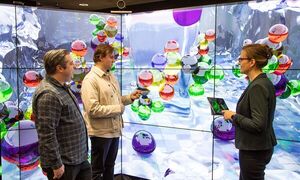
Scientists supercharge search for key ingredient of next-gen lithium batteries
"Scientists in Melbourne have used supercomputers to speed up the search for a key ingredient in the next generation of lithium-metal batteries, which could potentially increase storage capacity by 10-fold compared with today’s technology. The team led by RMIT University, in collaboration with CSIRO, say the work could benefit the development of batteries that allow electric vehicles to drive further and phones to last longer with a single charge. Senior lead researcher Professor Michelle Spencer from RMIT said the team used supercomputers to develop an ultra-fast way to screen hundreds of potential molecules that could make suitable electrolytes for lithium-metal batteries. “This work could benefit anyone wanting to use electronic devices, such as mobile phones and laptops, or electrified transportation like electric cars and future electric planes for commercial air travel,” said Spencer, a Professor of Chemistry and the Deputy Director of the STEM Centre for Digital Innovation. “Our work is only a small component of the large body of work being done in the rechargeable battery space, and electric flight for large-scale domestic and international travel is still a long way off.” Despite rapid advancements this type of battery still faces several challenges related to the stability of the electrolyte, Spencer said. “The formulation of electrolytes and the nature of their individual components are critical to the ultimate success of this exciting battery technology,” she said." [...]
Four terminal perovskite-silicon PV tandem devices hit 30% efficiency
"TNO, TU Eindhoven, imec and TU Delft, partners in Solliance, joined forces to further push the conversion efficiency of tandem solar cells to beyond the limits of today’s commercial photovoltaic (PV) modules. For the first time, four-terminal perovskite/silicon tandem devices with certified top cell pass the barrier of 30%. Such high efficiency enables more power per square meter and less cost per kWh. The result is presented during the 8th World Conference on Photovoltaic Energy Conversion (WCPEC-8) in Milan, and it has been achieved by combining the emerging perovskite solar cell with conventional silicon solar cell technologies. The perovskite cell that features transparent contacts and is part of the tandem stack has been independently certified. Additionally, achieving high-power density will create more opportunities to integrate these solar cells into construction and building elements, so that more existing surface area can be covered with PV modules." [...]

New evidence for liquid water beneath the south polar ice cap of Mars
"An international team of researchers has revealed new evidence for the possible existence of liquid water beneath the south polar ice cap of Mars. The researchers, led by the University of Cambridge, used spacecraft laser-altimeter measurements of the shape of the upper surface of the ice cap to identify subtle patterns in its height. They then showed that these patterns match computer model predictions for how a body of water beneath the ice cap would affect the surface. Their results agree with earlier ice-penetrating radar measurements that were originally interpreted to show a potential area of liquid water beneath the ice. There has been debate over the liquid water interpretation from the radar data alone, with some studies suggesting the radar signal is not due to liquid water. The results, reported in the journal Nature Astronomy, provide the first independent line of evidence, using data other than radar, that there is liquid water beneath Mars’ south polar ice cap." [...]

The cyborg of the future looks just like you
"How we connect the human body to technology isn't as scary as a science fiction movie, says UNSW Sydney neuroscientist Felix Aplin. When we think of cyborgs, what comes to mind? Ultra-futuristic beings with laser eyes and claw arms with a resemblance to Arnold Schwarzenegger. But the reality of cybernetic enhancement, or the integration of technology into our bodies to replace or enhance function, is very different. The field of cybernetic enhancement is hundreds of years old “We think of [cybernetic enhancement] as an ultra-futuristic technology, but… the field goes really far back,” said Dr Felix Aplin, from the Translational Neuroscience Facility at UNSW Medicine & Health. “Already from the 1800s people had this idea that maybe you could use electricity to replicate some functions.” Alessandro Volta (1745-1827) and Luigi Galvani (1737-1798) were the first to prove that animals use electricity in their bodies, with early experiments using electricity to stimulate muscle contractions in frogs and other animals." [...]

Researchers capture first images of carbon dioxide emissions from commercial aircraft engine
"Large-scale, chemical-specific emissions information poised to aid development of greener airplane engines and fuels Researchers have used a novel near-infrared light imaging technique to capture the first cross-sectional images of carbon dioxide in the exhaust plume of a commercial jet engine. This new state-of-the-art technology could help accelerate turbine combustion research aimed at developing engines and aviation fuels that are more environmentally friendly. “This approach, which we call chemical species tomography, provides real-time spatially resolved information for carbon dioxide emissions from a large-scale commercial engine,” said research team leader Michael Lengden from the University of Strathclyde in the U.K. “This information has not been available before at this industrial scale and is a big improvement over the current industry-standard emissions measurement, which involves taking gas from the exhaust to a gas analyzer system in a different location.” The researchers report the new research in the Optica Publishing Group journal Applied Optics. Chemical species tomography works much like the X-ray-based CT scans used in medicine, except that it uses near-infrared laser light tuned to the absorption wavelength of a target molecule and requires very fast imaging speeds to capture the dynamic processes of combustion. “The aviation industry is a major contributor to global carbon dioxide emissions so there is a need for turbine and fuel technologies to improve radically,” said Lengden. “By providing fully validated emissions measurements, our new method could help the industry develop new technology that reduces the environmental impact of aviation.” Imaging emissions from airplane engines Until now it has been impossible to image turbine combustion on test rigs containing a large airplane engine." [...]
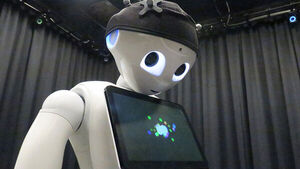
3D printing can now manufacture customized sensors for robots, pacemakers, and more
"A newly-developed 3D printing technique could be used to cost-effectively produce customized electronic “machines” the size of insects which enable advanced applications in robotics, medical devices and others. The breakthrough is seen as a potential game-changer for manufacturing chip-based microelectromechanical systems (MEMS). These mini-machines are mass-produced in large volumes for hundreds of electronic products, including smartphones and cars, where they provide positioning accuracy. But for more specialized manufacturing of sensors in smaller volumes, such as accelerometers for aircraft and vibration sensors for industrial machinery, MEMS technologies demand costly customization. Frank Niklaus, who led the research at KTH Royal Institute of Technology in Stockholm, says the new 3D printing technique, which was published in Nature Microsystems & Nanoengineering, provides a way to get around the limitations of conventional MEMS manufacturing. “The costs of manufacturing process development and device design optimizations do not scale down for lower production volumes,” he says." [...]

Full control of a six-qubit quantum processor in silicon
"Researchers at QuTech—a collaboration between the Delft University of Technology and TNO—have engineered a record number of six, silicon-based, spin qubits in a fully interoperable array. Importantly, the qubits can be operated with a low error-rate that is achieved with a new chip design, an automated calibration procedure, and new methods for qubit initialization and readout. These advances will contribute to a scalable quantum computer based on silicon. The results are published in Nature today. Different materials can be used to produce qubits, the quantum analogue to the bit of the classical computer, but no one knows which material will turn out to be best to build a large-scale quantum computer. To-date there have only been smaller demonstrations of silicon quantum chips with high quality qubit operations." [...]

Hooked on Photonics? Math to the Rescue
"An algorithm could reduce the effects of long-term drift in fiber Bragg-grating temperature sensors, making them potentially more useful to industry. Photonic thermometers – which measure temperature using light – have been around in optical fiber form for decades. These devices, called fiber Bragg gratings, are embedded in commercially available fibers thinner than a human hair, similar to the ones ubiquitous in network communications. Inexpensive and with the ability to be embedded into structures that might otherwise be difficult to access, the sensors are used routinely in civil infrastructure (which includes bridges and tunnels) and in the oil and gas industries. But they aren’t quite accurate enough for some other applications that might otherwise make use of them, including monitoring of freezers, ovens, medical-grade refrigerators, and certain industrial processes. One significant hit to the sensors’ accuracy comes from long-term drift." [...]
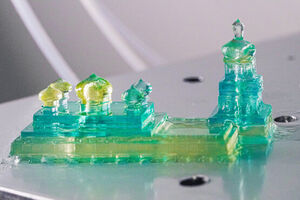
New 3D printing method designed by Stanford engineers promises faster printing with multiple materials
"Stanford engineers have designed a method of 3D printing that is 5 to 10 times faster than the quickest high-resolution printer currently available and is capable of using multiple types of resin in a single object. Advancements in 3D printing have made it easier for designers and engineers to customize projects, create physical prototypes at different scales, and produce structures that can’t be made with more traditional manufacturing techniques. But the technology still faces limitations – the process is slow and requires specific materials which, for the most part, must be used one at a time. Researchers at Stanford have developed a method of 3D printing that promises to create prints faster, using multiple types of resin in a single object. Their design, published recently in Science Advances, is 5 to 10 times faster than the quickest high-resolution printing method currently available and could potentially allow researchers to use thicker resins with better mechanical and electrical properties. “This new technology will help to fully realize the potential of 3D printing,” says Joseph DeSimone, the Sanjiv Sam Gambhir Professor in Translational Medicine and professor of radiology and of chemical engineering at Stanford and corresponding author on the paper." [...]
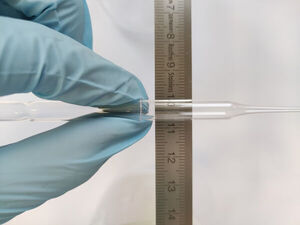
First single-crystal organometallic perovskite optical fibres
"Due to their very high efficiency in transporting electric charges from light, perovskites are known as the next generation material for solar panels and LED displays. We now have invented a brand-new application of perovskites as optical fibres. The results are published in Science Advances. Optical fibres are tiny wires as thin as a human hair, in which light travels at a superfast speed – 100 times faster than electrons in cables. These tiny optical fibres transmit the majority of our internet data. At present, most optical fibres are made of glass." [...]

Quantum technology reaches unprecedented control over captured light
"Researchers in quantum technology at Chalmers University of Technology have succeeded in developing a technique to control quantum states of light in a three-dimensional cavity. In addition to creating previously known states, the researchers are the first ever to demonstrate the long-sought cubic phase state. The breakthrough is an important step towards efficient error correction in quantum computers. “We have shown that our technology is on par with the best in the world,” says Simone Gasparinetti, who is head of a research group in experimental quantum physics at Chalmers and one of the study’s senior authors. Just as a conventional computer is based on bits that can take the value 0 or 1, the most common method of building a quantum computer uses a similar approach. Quantum mechanical systems with two different quantum states, known as quantum bits (qubits), are used as building blocks." [...]
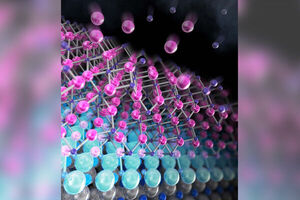
Upgrading your Computer to Quantum
"Computers that can make use of the "spooky" properties of quantum mechanics to solve problems faster than current technology may sound alluring, but first they must overcome a massive disadvantage. Scientists from Japan may have found the answer through their demonstration of how a superconducting material, niobium nitride, can be added to a nitride-semiconductor substrate as a flat, crystalline layer. This process may lead to the easy manufacturing of quantum qubits connected with conventional computer devices. The processes used to manufacture conventional silicon microprocessors have matured over decades and are constantly being refined and improved. In contrast, most quantum computing architectures must be designed mostly from scratch. However, finding a way to add quantum capabilities to existing fabrication lines, or even integrate quantum and conventional logic units in a single chip, might be able to vastly accelerate the adoption of these new systems." [...]

Metasurface engineered to create three different images depending on illumination
"New technology could offer a double safeguard to guard against counterfeiting Researchers have developed a metasurface device that can display three types of images depending on the illumination light. The three-channel device could be used as an anticounterfeiting measure or offer a new way to securely deliver encrypted information. “Metasurfaces are artificial materials with tiny nanostructures that can be used to manipulate light,” said research team member Qi Dai from Wuhan University in China. “In this work, we exploited both the size and orientation of the nanostructures to design a metasurface with three working modes.” The researchers describe the new device in the Optica Publishing Group journal Optics Express. They also showed that depending on the light used, the metasurface would generate a holographic image or a structural-color nanoprinting image with or without polarization-dependent watermarks. “Our tiny metasurface could be easily attached to currency, ID cards, credit cards, certificates, watches or rings for anticounterfeiting,” said Dai." [...]
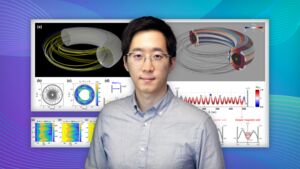
Scientists bring the fusion energy that lights the sun and stars closer to reality on Earth
"Physicists at the U.S. Department of Energy’s (DOE) Princeton Plasma Physics Laboratory (PPPL) have proposed the source of the sudden and puzzling collapse of heat that precedes disruptions that can damage doughnut-shaped tokamak fusion facilities. Coping with the source could overcome one of the most critical challenges that future fusion facilities will face and bring closer to reality the production on Earth of the fusion energy that drives the sun and stars. Researchers traced the collapse to the 3D disordering of the strong magnetic fields that bottle up the hot, charged plasma gas that fuels the reactions. “We proposed a novel way to understand the [disordered] field lines, which was usually ignored or poorly modeled in the previous studies,” said Min-Gu Yoo, a post-doctoral researcher at PPPL and lead author of a Physics of Plasmas paper selected as an editor’s pick together with a figure placed on the cover of the July issue. Yoo has since become a staff scientist at General Atomics in San Diego. The strong magnetic fields substitute in fusion facilities for the immense gravity that holds fusion reactions in place in celestial bodies." [...]
Documentação
A documentação é parte essencial do processo de aprendizagem e a Internet além de artigos interessantes de explorar também tem alguma documentação em formato PDF interessante de ler. Todos os links aqui apresentados são para conteúdo disponibilizado livremente pelo editor do livro.

The MagPi — Issue 122
"Retro gaming with Pico W. From Dizzy to Doom, Raspberry Pi Pico is able to hold its own against far more expensive emulation systems. Retro specialist KG Orphanides digs deep into the emerging world of retro gaming with RP2040. Build a Mini Magic Mirror. Shrink down a Raspberry Pi smart mirror with Raspberry Pi Zero to fit into smaller spaces. Create a range of intelligent screen projects including alarm clocks, digital information screens and web kiosks. Make a Pico mood light." [...]
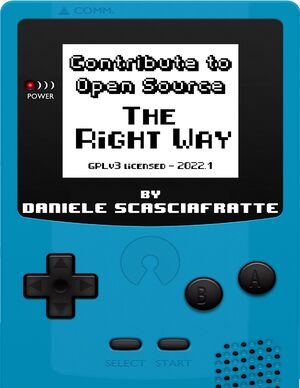
Contribute To Open Source: The Right Way 3Rd Edition
"Open Source is a topic that today is used also outside the IT world but nobody talks about how to be part of it, instead only to be a consumer or how can be profitable. Rome wasn’t build in a day but all the streets lead to Rome, we have all the streets but we are missing capable people to keep this world growing and improving. This book is my condensed personal experience in the last 12 years in various projects, communities and roles in Open Source. Including my best practice, tips and a lot of examples and resources. THIRD EDITION 2 years ago I published the 2nd edition, in the meantime various things changed like with the Covid situation and I missed the people during FOSS conference, that was one of the most inspiring things for this project. Anyway in these time I gathered over 80 links and new stuff so I written the 3rd edition." [...]
Projetos Maker
Diversos Projetos interessantes.

Red/Green/Blue Disco Tile
"A 16x16 Red/Green/Blue matrix display driven by shift registers, MOSFETs and a Arduino Pro Micro (old school electronics). This is an extension to my previous Red/Green Disco Tile. By using Red/Green/Blue 8x8 matrixes, more colors can be displayed. The only change to the circuit of the Red/Green variant was to add another DM13A shift register to handle the cathodes of the blue LEDs in the Red/Green/Blue Matrix. The anodes of the blue LEDs connect to those of the red and green LEDs. Rather than repeat the description of how a shift register works (see the description of the Red/Green Disco Tile), I would try an explain a technique called Bit Angle Modulation or BAM for short." [...]

USB PD Inverter
"The ATtiny212/412-based USB Power Delivery Inverter converts direct current from USB PD power supplies into sine wave alternating current with selectable voltage and adjustable frequency. For this purpose, the ATtiny's powerful Timer/Counter D (TCD) controls an H-Bridge with a subsequent low-pass filter. " [...]
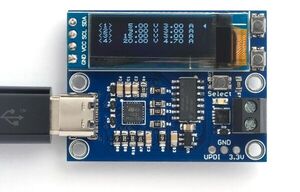
Power Deliverer
"This board allows you to use a USB-C power adapter as a power supply with a range of fixed voltages. It displays a list of the voltages and currents available from the adapter and allows you to select one. It's based on an STUSB4500 integrated circuit and an ATtiny1604 microcontroller, and it displays the information on a 128x32 OLED display. Introduction The original USB specification defined VBUS as a fixed 5V supply. USB-C extends this with a feature called Power Delivery. This allows a device to negotiate one of a number of fixed voltages from a USB-C Power Adapter: typically 5V, 9V, 12V, 15V, or 20V, at a current of up to 5A." [...]

Sound Reactive Rib Cage
"A hand-carved wooden rib cage with a heart of LEDs. The lights have several modes including a sound reactive heartbeat to the music. Use 3D model of a rib cage to find shape of each rib I chose this 3D model of a rib cage for its shape and because from the side view, most of the ribs are pretty much parallel. That was the key to support my whole assembly plan: to carve each rib individually out of a flat sheet of wood, and stack them at an offset like a staircase, pointed downward at a 20 degree angle. " [...]

PCMCIA Pico W Card
"My fascination with PCMCIA cards was created out of “necessity”. Most of my retro computing interest revolves around networking, and I wanted something that could natively attach to modern Wifi networks without the need to maintain an old linksys router just for my retro computers. There are many ways to do this, I just wanted something as clean and compact as possible. I was also left out of being able to use the various ESP based wifi modems as I mainly use an IBM PC110 and it has no serial port without a dock. At the start I looked at butchering existing ethernet cards and wiring in a wifi232 module coupling together the ethernet PHYs. This was very sketchy and the module was large, no real hope of scaling it down." [...]

ESP8266 Development Board Battery Powered and Solar Powered
"Custom designed ESP Based PCB Board for Battery-Powered IoT Applications with ESP8266, Battery powered, integration with Home Assistant This device is basically a development board based on ESP8266 chip and battery. You have 6 free I/O pins, you have free I2C pins, and you can attach as many sensors, relays, LEDs and other components as you want, and program it as you wish. This device has an integrated OLED display and a place for any I2C sensor. The main difference between this board and others you can find on AliExpress is in 2 things: 1.) LDO voltage regulator - most boards such as Wemos, NodeMCU and others have an AMS117 voltage regulator that has an extremely high drop-out voltage of 1.3V, which makes them unusable for battery power, except for programming, gaming, learning, if you just want to see that what you made works, this board has a HT7333 LDO voltage regulator which has an extremely low drop-out voltage somewhere around 150mV, you can also check the specification of the regulator on the internet. In this way, the device can receive from 3.3V-6V and always give the micro-controller 3.3v and power other components such as OLED display, Sensor without any problems." [...]

Clone PI-W Atmega8 (Arduino) Metal Detector short Review
"Inexpensive and extremely stable and sensitive metal detector made using an Atmega8 microcontroller. Quite by chance these days I got in my hands a "Clone PI W" metal detector module, so I decided to immediately do a small review and compare it with my previously made DIY Metal Detectors. At first glance, the module is solidly made, the elements are precisely placed and well soldered. The price is less than $50, including postage. In this case, it is an SMD version of this detector, and you can find the same metal detector made with standard components made according to an identical schematic diagram. For the power source I use three lithium-ion batteries connected in series and it is just under 12V." [...]

Wireless Die and Wireless Receiver Using ESP-Now (Mental Die)
"The primary function of this die is to perform a magic trick. The Trick: Give this die to a friend or observer and ask them to keep it under a glass, while you have turned your back on them. And you will correctly guess the number on top. The die wirelessly transmits the die number to a small display. You can see the number on the display and correctly guess it. The die is 99% accurate, with the exception of the battery running out." [...]
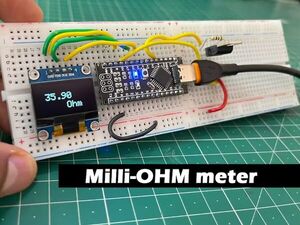
Milliohm meter theory and project
"let's measure the smallest resistance ever posses by any wire or any shunt. The proper use of OHM's law with practical. Previously, I made some tutorials regarding current measurements using shunt resistor. Basically, shunt is small known resistance which is in series with the load. And by measuring the voltage drop across the resistor we can find the value of current flowing in the circuit. All credit goes to Ohm’s law: V=IR, by knowing the two of them we can find the 3rd value." [...]
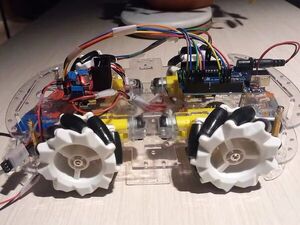
Simple Bluetooth Car with Android App
"Build a simple l298n enabled car with an arduino uno and 4 dc motor drivers and code the android app! Welcome to the Easy Arduino Bluetooth Car This project is designed to teach someone to build a simple Arduino enabled car, with commonly accessible parts. I wanted to bring together the learnings from my experience build a car without a readymade kit. It works with easy to find parts and requires no paid android applications to run. It works by connecting the android app to the hc-05 and voila! The car will go left, right, forward and backwards !" [...]
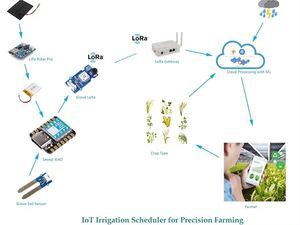
Solar Power Irrigation Schedular for Precision Farming
"Monitor soil moisture accurately in real-time, anytime from anywhere, for optimal irrigation scheduling. The Problem Agriculture accounts for around 70% of all water withdrawals globally according to the World Bank, and approximately 60% of that is wasted, largely due to inefficient applications according to the UN’s Food and Agriculture Organisation (FAO). With water increasingly valuable against the backdrop of a rising human population and climate change, can IoT & AI be used to prevent water wastage? The Solution Simple techniques like rainwater harvesting and wastewater recycling are already being used in many regions to reduce water consumption. And many farms have realized the benefits of replacing their surface and sprinkler irrigation systems with more efficient drip irrigation systems. One big reason for water waste is that the farmers don't know exactly when watering is required and how much water a specific plant needs to grow." [...]
How to Make a Neopixel Rainbow Clock
"I know making a clock sounds a little irrelevant, especially nowadays because we all have smartphones and no one is going to use or look into the clock for time, but it is good when you are doing some work or during a workout. So, I decided to make one Arduino digital clock for my room. While searching for the clock model, I got thousands of designs but most of them used seven-segment displays and I wanted to build a unique and colourful clock without using Seven segment displays. So, here I am going to use Neo-Pixel LEDs with Arduino pro mini and RTC module. About the clock I made, it's a very simple clock that shows time and room temperature and the main feature of this clock is that the colour of the digits changes every minute. Supplies: - Arduino Pro Mini - DS3231 RTC Module - WS2812 Neo pixel LEDs- 42nos - 2× Push Button - Switch - AMS1117 Voltage Regulator - 330-ohm Resistor - 3D printed structure - 3.7v li-ion battery - TP4056 charging module - MT3608 booster module" [...]

Project-l0ckcr4ck3r
"This robot is a true creation of the idea many years ago brought on by Samy Kamkar's robot that "utilized" his algorithm for cracking combination locks. Samy Kamkar never demonstrated his robot actually performing the algorithm, though he implied multiple times that it does do it. I've always wanted to build a robot that actually decodes locks while maintaining a cool desk toy vibe! I am quite happy with the user-oriented design and doubles as a nice fidgety-toy-thing to play with. This robot is able to decode the majority of locks that don't have much wear and tear on it and usually takes ~40 seconds. " [...]
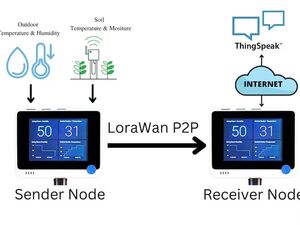
LoraWan Based Smart Agriculture Monitoring
"In this project I will demonstrate how we can use Smart Agriculture Devices using Long Range Communication(LoraWan) in Rural areas. Agriculture is a backbone of very country as it fulfills the local demand as well as helps to generate the revenue by exporting and due to rapid growth of population Food safety is becoming very huge concern as it's creating food scarcity. But due to rapid growth of technology we can use the resources very wisely to increase the crops yields like by deploying sensors in the field and controlling the use of water, fertilizer and pesticides and later with the use of ML/AI we can take necessary steps to prevent our crops from water scarcity and harsh weathers. In this whole setup communication plays very vital role to send the information from farms to cloud. Right now researchers are using different types of communication technologies like 3G/4G, GSM, Wi-Fi, Bluetooth, Zigee, some are long range and some are short range but still there are issues with long range communication like in under developed countries still there are rural areas where mobile communication is issue, range is also issue but 3G/4G connections are also expensive if we talk about hundreds of devices as each devices requies sim card with separate package. To overcome the above 2 issues which is connectivity and cost there is a new communication technology called lorawan which is providing long range connectivity and no monthly charges so we can easliy sense our firms without paying heavy monthly charges to cellular companies." [...]
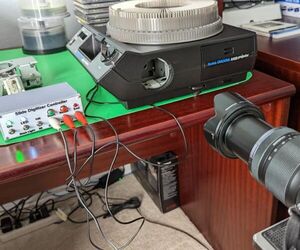
Automated 35mm Slide Digitizer
"My parents were avid travellers and photographers and took thousands of 35 mm slides documenting our many trips when I was growing up. I was bitten by the same bug, and have fully "documented" my travels in the 70's and 80's with 35 mm slides. For years we would watch our travel slides projected onto a screen using a Kodak Carousel projector. The slides were organized in carousel trays holding either 80 or 140 slides. Over the last 30+ years, the slides have only been seen a few times as it requires a dark room and some setup (projector, screen, etc.) I decided it was time to convert the family slides into digital images that could be easily viewed on a PC or TV and shared with my childeren and grandchildren." [...]

Project Agouti
"Intelligent acoustic monitoring made accessible Motivation & Background Traditional vision-based wildlife monitoring methods are limited by weather conditions, the camera's field of view, the size of target organisms, and their proximity. There is great room for alternative technologies which can monitor wildlife more reliably through other channels: like acoustic monitoring. Acoustic monitoring offers a reliable, low-cost, and scalable alternative to monitor wildlife, with the added bonus of detecting harmful human activity: whilst poaching and logging may be impossible to see, they are much easier to hear. Of course, acoustic monitoring is not a new idea. However, most products only record; they don’t analyze. This gives rise to huge quantities of raw data which exceeds the manpower of researchers to analyse individually." [...]

Rooftop tomato plant monitoring system
"A rooftop tomato plant monitoring system powered by SenseCap K1100 kit is presented in this project. Due to the crisis of agriculture land, it very much important to think about rooftop gardening for food security. Regular maintenance is important for any type of garden. We do rooftop gardening as a hobby. Many of us do not know how to take proper care of the garden. An automated system that can help us in our rooftop gardening, is presented throughout this project." [...]

Breadboard Air guitar
"Using 2 ultrasonic sensors to detect the strum motion. And using 3 buttons to play the node The project started with using an ultrasonic sensor to detect distances. Then I thought of using two ultrasonic sensors to tell the passing object‘s movement direction by detecting the change in the measured distance between two sensors. During the testing, the hand wave I used for testing, reminds me of guitar strumming. So I thought of using this to make an air guitar. I mean who can say no to air guitars." [...]

Smart Bike Suspension
"An automatic suspension adjustment on a bicycle that able to understand the character of the terrain and the activities of the rider. In this project we use data from the motion sensor on the Arduino Nano 33 BLE Sense which is mounted on a bike’s suspension and used under different road conditions. The data was cut into 5 seconds and labeled according to the surface variation and activities. Then processed in Edge Impulse Studio through Neural Network blocks: Spectral Analysis (x, y, z acc) and Classification (Keras) which will produce an ML model that can detect 5 road surface characters and rider activity output (idle, medium, rough, smooth, sprint). The model is deployed into the program on the Nano 33 BLE Sense which has an angle servo motor installed that can adjust the bike’s suspension knob. In the end, this project succeeded in implementing a "smart" system on the bike's suspension which can automatically adjust the level of travel on the suspension (lock, medium, open) according to the character of the road and the activities." [...]
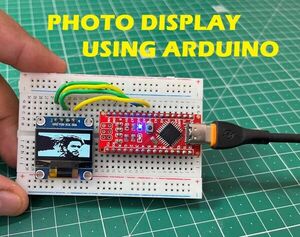
OLED Is My New Picture Gallery
"Displaying pictures and QR on a OLED display using Arduino in a easy way. Let's build this project to get more out of the ancient 0.96" led Required Elements: 1) Image file of QR 2) Arduino Nano 3) OLED display 4) 9V battery 5) PCB shield from PCBWAY In this tutorial, we will build a project with OLED to display different images/ QR using Arduino. Using this you can display any static image on the screen. First, we will modify the image using photo editor and then convert into Arduino compatible hex code. Which then required to light up the single pixel accordingly to the code. The same approach can be used to run a video on this display, which we will try to cover soon." [...]
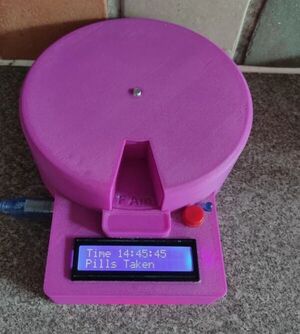
Automatic Pill or Medication Dispenser
"I created this pill or medication dispenser because my wife has to take several tablets in the morning and evening and was getting confused with which tablets she had taken and therefore not always taking the right medication at the correct time. I wanted a simple system that would effectively dispense the correct tablets morning and evening. It had to have a display to indicate when the tablets were ready and a timer to adjust when they were dispensed. Supplies These are the supplies required for creating the dispenser with approximate UK prices: Arduino Uno Board and USB cable £5 LCD display 1602 12C 16x2 £5 Clock DS3231 £4 Motor 28BYJ Stepper motor and ULN2003 driver £7 5mm LED Push button switch and Cap Wire for connections Connector block M6 50mm bolt Glue gun Superglue Soldering iron and solder 3D printer and PLA" [...]

8x8x8 LED Cube Using Arduino
"I made a 8x8x8 LED cube by myself with using Arduino. It was a big project, it took almost a month to finish it, but it worth every time. The cube has 8 types of flash and you can switch between the modes with a button. Components: - 512x 5mm LEDs (8x8x8, green, red or blue) - 1x large prototyping board (100x100 is enough) - 64x resistors (220 Ohm) - 9x 74HC574 ICs - 9x 20 pin IC sockets - 16x PN2222 transistors - 1x pushbuttons - Arduino Uno - A lot of wires - Piece of wood for template and base - 5v power supply (Personally I used a power bank) Tools: - Solder - Soldering Iron - Helping Hands - Wire cutter - Paint (for the box) - Fan (for fresh air due soldering)" [...]
Secção Videos
Videos interessantes.
That's all Folks!



